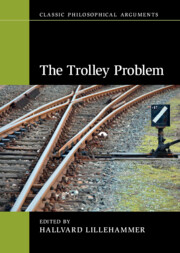Book contents
- The Trolley Problem
- Classic Philosophical Arguments
- The Trolley Problem
- Copyright page
- Contents
- Tables
- Contributors
- Acknowledgments
- Introduction
- 1 Keeping track of your trolleys
- 2 Shunted trolleys and other diversions
- 3 Must we turn the trolley?
- 4 Non-consequentialism in light of the trolley problem
- 5 Non-consequentialist principles under conditions of uncertainty
- 6 The trolley problem and the doing/allowing distinction
- 7 Virtue ethics and the trolley problem
- 8 Trolley dilemmas from the philosopher’s armchair to the psychologist’s lab
- 9 Trolleyology
- 10 Cross-cultural responses to trolley problems and their implications for moral philosophy or
- 11 Ethical accident algorithms for autonomous vehicles and the trolley problem
- 12 A new trolley problem?
- Bibliography
- Index
8 - Trolley dilemmas from the philosopher’s armchair to the psychologist’s lab
Published online by Cambridge University Press: 24 February 2023
- The Trolley Problem
- Classic Philosophical Arguments
- The Trolley Problem
- Copyright page
- Contents
- Tables
- Contributors
- Acknowledgments
- Introduction
- 1 Keeping track of your trolleys
- 2 Shunted trolleys and other diversions
- 3 Must we turn the trolley?
- 4 Non-consequentialism in light of the trolley problem
- 5 Non-consequentialist principles under conditions of uncertainty
- 6 The trolley problem and the doing/allowing distinction
- 7 Virtue ethics and the trolley problem
- 8 Trolley dilemmas from the philosopher’s armchair to the psychologist’s lab
- 9 Trolleyology
- 10 Cross-cultural responses to trolley problems and their implications for moral philosophy or
- 11 Ethical accident algorithms for autonomous vehicles and the trolley problem
- 12 A new trolley problem?
- Bibliography
- Index
Summary
Trolley dilemmas were first developed by moral philosophers engaged in reflection on the ethics of permissible harm. But they have since become central to psychological research into morality. One reason why psychologists have paid so much attention to trolley dilemmas is that they see them as a key way to investigating the contrast between deontological and utilitarian approaches to ethics. This framing, however, departs from the original philosophical purpose of trolley dilemmas, and can lead psychological research astray. In this chapter, we question the assumption that trolley dilemmas can shed general light about the psychological bases of utilitarian decision-making. Some lay responses to trolley dilemmas that psychologists routinely classify as "utilitarian" in fact have little meaningful relation to what philosophers mean by this term. Even when what underlies lay responses to trolley dilemmas partly echoes aspects of a utilitarian approach to ethics, this doesn’t generalize to other moral domains, and tells us little about the psychological roots of other aspects of utilitarianism. Properly used, trolley dilemmas have a useful role to play in psychological research. But once we get clear about what we can, and cannot, learn from them, the current centrality of the trolley paradigm in moral psychology will seem overblown.
Keywords
- Type
- Chapter
- Information
- The Trolley Problem , pp. 134 - 157Publisher: Cambridge University PressPrint publication year: 2023
- 1
- Cited by

